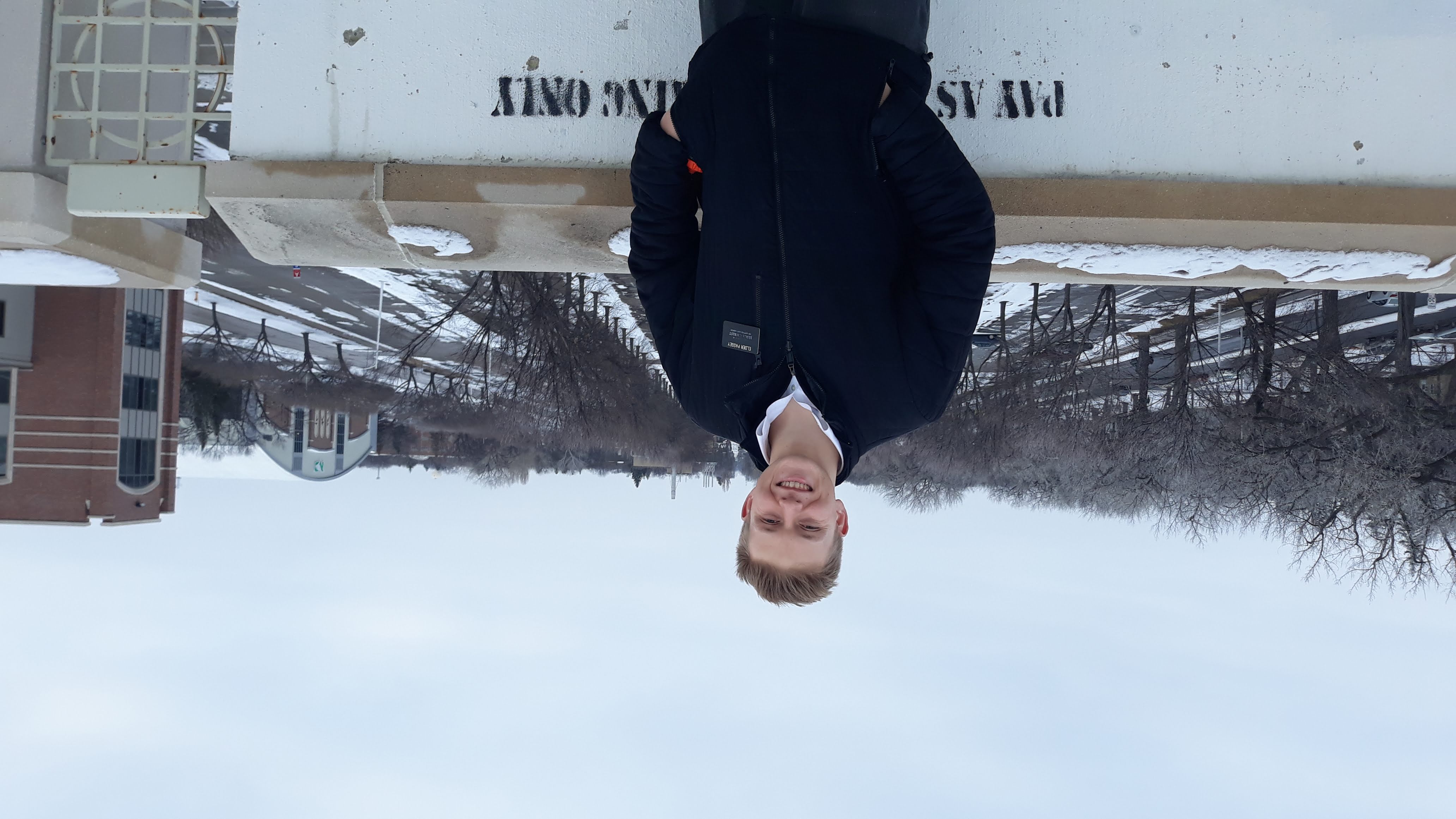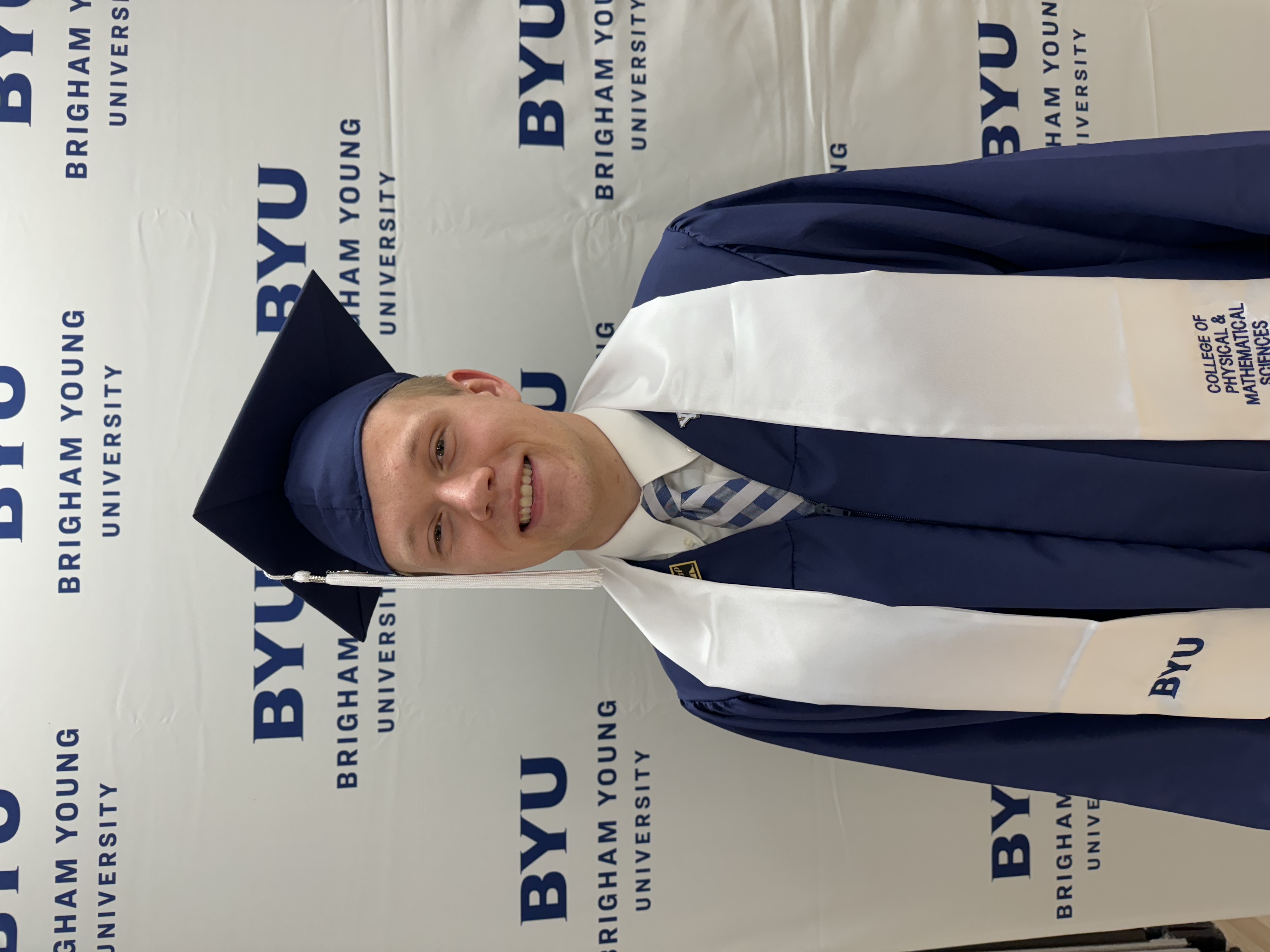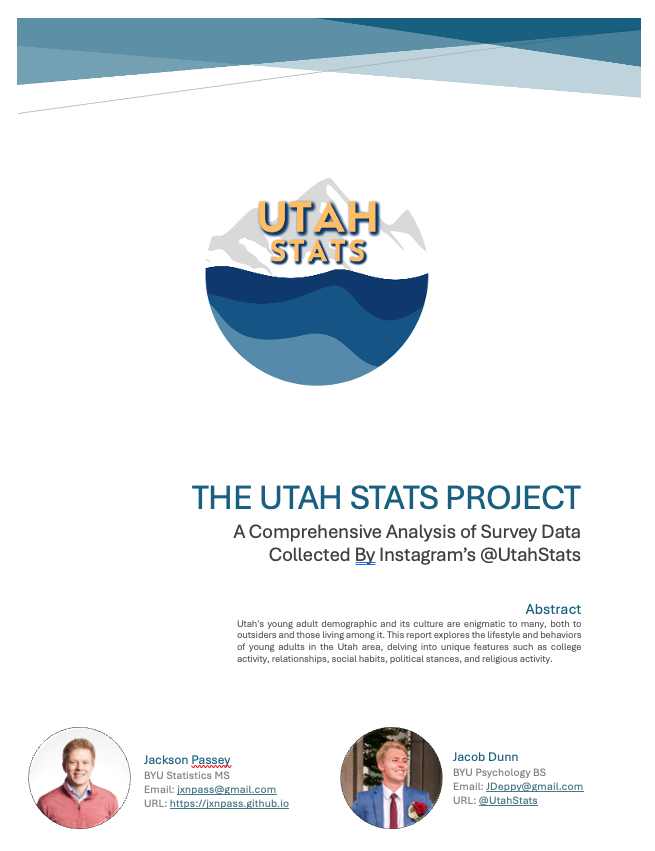
Biography
My name is Jackson Passey and I absolutely love all things research. When I get into a new project, I get very excited, already diving into the data to see what stories are being told, try out new models and visuals, and portray to collaborators what we can learn. I especially enjoy data about people, deciphering their experiences and lifestyles, confirming or debunking stereotypes, and making sense of nonsensical human behvaior. I aim to attain a career that allows me to apply the same passion and desire to study cultural and behavioral trends through data analytics and artificial intelligence.
My family grew up in Laguna Hills, CA and moved to Gilbert, AZ just before starting high school. My two parents raise my brother with severe autism, who has also been a major motivation for me to succeed in academics and technical skills for a future career. After high school, I served a two year mission for the Church of Jesus Christ of Latter-day Saints in Bismarck, ND, and afterwards enrolling into BYU to major in statistics and minor in mathematics. During my time at BYU, I developed skills in inference, modeling predictions, mathematics, data visualization, feature engineering, and programming softwares like R, Python, SQL, SAS, and Excel. I also was able to work internships and student-level jobs in professor-advised research, Provo Missionary Training Center, and Swire Coca-Cola.
As of now, I am enrolled in BYU’s MS Statistics program with the graduation date set to April 2026. I look foward to furthering my education in statistics and getting exposed to new and more challenging projects.
Timeline (and Resume)
2015-2019
I went to Campo Verde High School located in Gilbert, AZ. I spent a lot of my time in high school devoted to sports, namely football and soccer. My original passion and goal used to be to be a scholarship football kicker and punter for D1 school like BYU, but by the time I entered senior year, I realized I had a much better chance getting into BYU with academics rather than sports. I was ranked as a D2 kicker (4.0 stars) on a professional kickers/punters rankings list, but my grades, ACT score, and other extracurriculars (mathlete, soccer, and a regular volunteer for the local Special Olympics groups) projected me for greater education.
While I have only a little regret for my decision to not pursue collegiate sports, I believe that trying to excel in academics while balancing sports would have been very difficult to do. But that doesn’t mean I still like to talk about it! Below is a picture of me kicking a 51-yard field goal to set a high school record for longest field goal.
What was absolutely crucial for my introduction to statistics was my AP Statistics class. Because of my move to California, the high school-level math classes from my junior high school time, which was supposed to count for high school credit, did not count because of the move. Therefore, I had to take four years of higher level math classes. I took AP Calculus AB and BC my sophomore and junior years, and then AP Statistics my senior year. I was indifferent about calculus, but I loved statistics. To see how statistics applied to so much of the world, like sports, research, business, and virtually any topic, I fell in love immediately. I decided after completing the math course I would study statistics as my major at BYU.
2019-2021
I then decided to serve a mission for the Church of Jesus Christ of Latter-day Saints. To those unfamiliar with an LDS mission, young men (and women) sacrifice two years (1.5 years) after graduating from high school to teach about their faith to those interested. They can be sent almost anywhere in the world.
I learned a lot about how to be an understanding leader, which admittedly was something I struggled to be at first. I learned how to help my peers in multiple ways, whether that was demonstrating how to succeed in finding people to teach, setting plans to achieve goals, or even to be emotionally supportive in times of need. One of the most memorable experiences was that at the end of my mission, my mission president asked me to travel around the entire mission for my last six weeks and instruct other missionaries the tips and tricks I learned to achieve success during my two-year mission. It was a tremendous experience being able to help those missionaries invigorate and inspire them to work hard before I ended my mission.

2021-2024
Starting BYU
Now as a new statistics student at BYU, I was dedicated to working hard in my new program and preparing myself as much as I can to have an impressive graduate school application. I knew before I even began my first class I wanted to pursue a masters degree, and so I wanted to position myself to finding out what experiences I need to get there.
My first statistics contact was the data science club president at BYU. He offered to work with students in the club to help build their resume and attain internships. I figured he would have great advice. The first thing he did was heavily critique my resume. All I had on my resume was bullet points from my mission and a grocery store job from high school, along with the occasional award. He helped reshape my resume and then suggested I work with a professor as soon as possible to get into research. Working as a research assistant will be much more crucial for technical development than classes. I thanked him and then directed my next objective to get into research.
Research Assistant
My second point of contact, and the one I have had for years, was my first BYU Statistics Professor, Dr. William Christensen. He taught a class that introduced concepts like ANOVA, data wrangling, power analysis, and pairwise comparisons. He also taught the generals statistics class. I did a preliminary scan on the topics he has interest in researching, and noticed he has experience and written publications in environmental sciences, psychology, nutrition, and anatomy – topics I find intriguing in as well. I asked him what it takes to be a research assistant for him, and he recommended I work as a teaching assistant first.
After working as his TA for a semester, I applied and was offered the job to work as his newest research assistant. This was a dream-come true for me: this will be my first step actually applying statistics in my work and getting paid to do so! My first project involved assisting another RA to model knee movement in a device for the BYU engineering department. This work introduced me to countless types of machine learning algorithms, namely change point regression, weighted linear regression, random forests, Bayesian Additive Regression Trees (BART), and spline models. My second project was to coordinate with the Nutrition and Dietetics department and produce visuals and results for an experiment involving drinks and cognition (project description found in another blog post). There were some other side projects as well, namely one that focused on a young athlete training experiment that introduced me to power analyses, and others that involved consulting PhD students for their papers. None of these others lasted as long and taught me as much as the other two mentioned.
First Internship - MTC
In the summer of 2023 I applied and volunteered to work as a Research and Evaluation Intern for the Provo Missionary Training Center. My task was to analyze missionaries who have completed their training and are now entering their mission fields via survey results. In this survey, they answered two questions – what was the hardest part of your MTC experience, and what was the most important thing you learned? The tricky part of this data was that the responses were open-ended, meaning that any statistics or calculations would be uninterpreted. In addition, there were 60,000+ respondents. There needed to be a viable way to process this data and make it meaningful. Here is what I did:
- I stratified the sample. 400 missionaries from each MTC, 100 are U.S. born native speaking, 100 are U.S. born studying a foreign language, 100 are internaitonal native speaking, and 100 are international studying a foreign language.
- From the 400, I then read through each response and categorized them into two potential group. A group or category can be, for example, when asked what was hard about the training, learning the language, dealing with homesickness, or struggling with anxiety. The R&E team had a master sheet on hand for me that they use for when they handle open-ended responses.
- Once each response had one or two categories listed and data now standardized, we were able to perform analyses, make visuals, and report findings.
The LDS Church is very sensitive about its data and code, so I cannot specify particular findings or discoveries, but something my work did introduce me to was how homesickness was a much more major issue for native speaking missionaries than it was for missionaries learning a new language. This might be due to the additional weeks foreign speaking missionaries have to adjust to their new lifestyle, and therefore more time to battle homesickness. Or, and more likely, most missionaries learning a language admit that learning the language is the hardest part of the MTC, which will obviously dominate as an issue compared to native speaking missionaries. Either way, it was a very intriguing internship and was grateful for the experience.
BYU Statistics Club Presidential Term
The BYU Statistics club was founded by a group of 10 of us, including me and some other friends in my statistics major that felt there were some missing elements to the BYU Department, and only the students could provide them. We wanted to foster a student-led community that focused on developing skills and having fun with learning statistics. It became a hit almost instantly, as it gained tremendous support from the department and grew to 100+ members in the first month.
When I was elected president in 2023, I wanted to accomplish two things: I want the students to have plenty of various events to attend, and I want the club leadership to have experiences they can put on their resume. So I led a group of 25 peers to plan events, invite guests, cater food, advertise, take pictures, manage finances, and many other tasks. With lots of help and dedication from this team, we were able to host almost 50 events, half of them were recruiters talking with our students, adding 80+ members to our club, and 1500 total attendnaces for the entire year. Beacuse of the success demonstrated from club leadership in being able to generate such activity, the department transitioned volunteer roles in club leadership to becoming a part-time paid job! I learned a great deal about leadership, communicating with others, and, of course, statistics.

Graduation from BYU
In April 2024, I graduated from BYU with a bachelor’s in statistical science and a minor in mathematics. I was able to attain a 4.0 my entire undergraduate college education, and earned multiple academic awards like Dean’s List Scholar, Summa Cum Laude alumn, and co-valedictorian (and just feel like I need to mention, they gave that last title to around 20 other students).

Second Internship - Swire Coca-Cola
For the summer of 2024 I interned as a Category Market Insights intern for Swire Coca-Cola, headquartered in Draper, UT. The “Category” part of this role was to analyze characteristics, sales, trends, etc. of different types of drinks in the market, namely your standard soda, energy drinks, sports drinks, and all other non-alcoholic beverages. My role as the intern was to develop a Power BI Interface for the Swire space planning team that analyzed the drinks on the shelves of convenience stores and calculated the changes made due to contracts each year. Swire and competing bottling companies work with grocery, convenience, club, and supermarket stores to place as much of their products on the shelf. The type and quantity of drinks were important features this dashboard needed to display for the space planning team, with most of the calculations looking to track changes in shelf space, shelf ownership, and points of distribution (or POD, calculates how many products given category, company, etc. is in stores).
This was my first exposure to Power BI, which is a very powerful analytics software that is not taught in my statistics curriculum. I learned a lot about data sources and ingestion methods, Power Query and DAX calculations, creating aesthetic and informative visuals, and user experience. I ended the internship with the dashboard pushed to production and trained a team of 12+ members to use it for their needs.
External Project - UtahStats Instagram
At the tailend of my 2024 summer, I collaborated with Instagram’s UtahStats to generate a PDF report of this profile’s most unique findings from his profile. UtahStats is ran by a BYU Psychology student interested in learning about the cultural and social norms of young adults living in Provo/Orem UT, particularly when it comes to dating. He collects his data through volunteers that respond to a ten-minute survey linked on his profile. This project turned out to be a unique challenge as I now had to transition my skills in statistics complex modeling solutions and analyses to storytelling with data.
The report has 40 pages of very simple and “eye-catching” visuals. It highlights trends in the scope of college activity, lifestyle, religion, politics, and dating. I also made sure that, whenever there was any correlation or significance detected, I kept the explanation simple: a p-value, confidence interval, or other statistic would be reported to demonstrate significance. The numbers are to suggest I performed valid tests and exhibited great attention to the details of the report without going too far into the scientific jargon or methodologies. Any text would expound upon the visuals and reveal possibilities or circumstances about why the data is the way it is presented.
I mention this project because it is aligned with my field of interest: to have a career that puts itself in the shoes of people, using data to interpret their behavior and views, and decipher trends from the research is in the realm of statistics I hope to work in.
